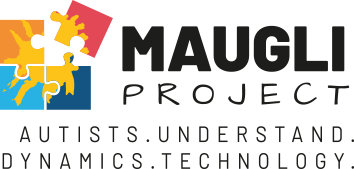Why?
Maugli hardly ever looks for any contact with other people. Maybe never. Yet he can also hear, see and feel. But his mind and brain can handle the stimuli coming into his inner world in a different way. He is often unable to add intellective meaning to his perceptions. For instance, words mean very little to him, therefore it is more difficult for him to adapt to the world. He does not understand, for example,why we smile at him when he does nice work.
He is socially blind, therefore it is problematic for him to unscramble other peolple’s emotions or intentions. Maugli lives with autism or, as the specialists and helpers say, have Autistic Spectrum Disorder. According to our present knowledge, it accompanies him all through his life.
We do not know exactly that Maugli is one out of a hundred or of sixty-four children. That is, we do not know how many are exactly affected.
Maugli lives in Hungary, where people know little about him and his peers, as well as about autism itself. He is supported by excellent specialists, many are involved in trying to open a window for him to the outside world. Many of his fellows yet do not get the chance that their attributes are recognized and the proper development is provided.
Maugli also uses infocommunication tools. Why not use the applications of new technologies, the Internet and the virtual world. Innovative, tailor-made solutions can help him sooner or later get through the zebra crossing alone.
In the interest of Maugli and his fellows, we need to increase the understanding of the society. Imagine we needed to adapt to their world! The enthusiastic specialists as well as the worried parents - who leave for their exploration path despite their own original intentions- can be part of the results. The stake is Maugli's security and the fulfillment of his life.
What We Do?
Theoretical elaboration of the test method
Creating a tool kit system
Creating a reference database
eye & motion tracking
special (voice) gaming
robot eye image analyzing
autistic art works
big data mining
artificial intelligence development
Teams
autism experts
visual expression psychologists
game creator
art therapists
music technology experts
big data experts
artificial intelligence experts
Aims
Our common social goal is to measure the effectiveness of therapeutic methods that support the development of autistic children, as well as to develop a toolkit for tracking the child's continuous development.
After early detection, the right development therapies are the greatest help for children. Therefore, making the effectiveness of the proposed therapies measurable is a prerequisite for success. By means of this toolkit, the change in children can be measured.
The goal is Maugli's development and for this purpose also the use of predictions based on understanding. A possible tool to reach this goal can be linking hybrid solutions that have never or little been used so far and which make it possible to track changes in Maugli. Maugli's drawings, eye movements, and facial expression reflect his inner state of mind. The interpretation of these above not only facilitates the tracking of changes, but also the decision about where to go further.
What do we do for Maugli?
- we use the movements of his look, the changes in his emotions and the images he creates to elaborate on what kind of data can be collected and how they can be used;
- we make the results of his developments measurable;
- we create simulation models to show why we need to develop him in a specific direction;
- we examine how these results can be utilised in the society as well.
The Project
Pupils Do Not Lie
EYE CAMERA
Maugli's condition is evaluated using eye camera test method that can contribute to the early detection of different developmental patterns, based on our assumptions and foreign models. Our tests on a small sample showed that children with autism have different look order. They mostly perceived and followed the mimicry and hand gestures of the characters in the movie. The objects are in the focus of their attention only when they are used, in direct interaction with the characters. In texts the children's attention is scattered, they are not able to concentrate on them.
Mimicry of Emotions
FACE-READING SYSTEM
While the eye camera captures the unconscious eye movement of Maugli as well as the frequency and time of the selection of image stimulants, the other camera as a face-reading system reads the children's emotional responses. The face-reading system is able to detect the basic emotions by capturing the mimic changes of the face points. The face-reading system makes the recognition of children’s characterictic mimic changes possible.
Maugli’s Drawing’s
ROBOTEYE
The specific question of image analysis is which are the image characteristics that provide substantive information in case of certain consequences or consequence variables. We examine Maugli's randomly selected drawings based on randomly selected features!
Can the drawings be telltale about Maugli? If so, is it possible to work "only" on the basis of the drawings, and if so, along what goals and methods? As so far the meaning of the drawings had to be supported basically by interviews, questionnaires and other diagnostic tools. Is it possible to sort our knowledge about Maugli by the characteristics of his drawings? Can it work as a kind of diagnosis, a precursor of the therapy?
Results
We enter to their world to understand it. We created a tool- and a fate database to support the work of day-to-day caretaker staff and to measure the results of everyday therapeutic work.

email: maugli@infoter.eu
web: http://maugli.infoter.eu/en
Supporters
Autistic Art Public Benefit Foundation
https://autisticart.hu
ETresearch
http://etresearch.hu
Every Day Autism blog
http://namaugli.blogspot.com
MyXteam- research
http://my-x.hu
